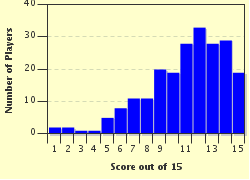Quiz Answer Key and Fun Facts
1. In this 1605 novel by Miguel de Cervantes, the protagonist's name was Alonso Quixano. But later in the story the character's name changes. It is preceded by a word which means "Lord" in Spanish. What is the last name of this wildly delusional, but entertaining heroic man who gives the book its title?
2. This 1748 work, written by Samuel Richardson, is about an innocent, principled young woman - she of the title - being criminally harassed and seduced by a rake named Robert Lovelace. The book is written as a series of letters. Who is this poor unfortunate heroine in the novel's title?
3. In 1749 Henry Fielding wrote a rollicking novel of lusty high-spirited contemporary events. The novel usually is known only by the name of the hero, but was actually formally titled "The History of ____ ______, a Foundling". What is the full name of this foundling?
4. Charles Dickens wrote about this man in his 1844 novel. Dickens thought it was his best work, but it is his least popular novel. It seems readers weren't that interested in the life and adventures of Mr. Chuzzlewit. Are we interested enough to remember the hero's first name?
5. In 1850 Jane Austen wrote about this meddlesome young woman who was chastened by and eventually married to an older, serious neighbour, the wise Mr. Knightley. The heroine's name and the title of this novel is "Elizabeth".
6. George Eliot wrote about this man in 1861. The novel's sub-title, a description of this hero, is "The Weaver of Raveloe". Who is this tragic figure who finds love and redemption with his adopted daughter, Eppie?
7. Leo Tolstoy's 1877 masterpiece is the story of a woman named Anna who married a man she did not love. Subsequently she found passion with a gallant young Count with whom she conducted a tempestuous, scandalous affair. Finally she committed suicide by throwing herself under a train. What was her last name?
8. This woman's name is the title of a play written by the famous Norwegian playwright Henrik Ibsen in 1890. This heroine commits suicide after her lover has killed himself, and when she realizes that a neighbour is going to tell her husband the truth about this affair. Who is this doomed woman?
9. Joseph Conrad published this work in 1900. The novel's title is the name given to the hero by the Malay people whose community he saves from the threats and terrorization of a local bandit gang. The book's title contains an aristocratic title in itself. What is this book called?
10. Edith Wharton, whose highly popular novel "The Age of Innocence" was made into a successful 1993 film by Martin Scorcese, wrote many other outstanding works. A novel about this man was published in 1911. He lived in the fictitious community of Starkfield, Massachusetts. Who was he?
11. E.B. White published this children's story in 1945. This time I am giving you the title because the hero is not a human being. You need to guess what "Stuart Little" actually was.
12. Vladimir Nabokov's controversial 1955 novel is about a 38-year-old man who becomes sexually obsessed with a 13 year-old girl named Dolores Haze after he becomes her step-father. The novel's title is the fantasy first name that the man assigns to his victim. The title is ________?
13. This novel is about a young Jewish girl called Marjorie Morgenstern who wants to be an actress. The title of this novel, written in 1955 by Herman Wouk, is the stage name which Marjorie dreams of using to put her name in lights. What is this name?
14. Elizabeth Strout won a Pulitzer Prize for this 2008 novel. The work is unusual because it is a series of 13 short stories which are not linked in any direct way other than that they feature the title character, and some recurring characters in a Maine seaside town. Who is the woman whose name is this book's title?
15. Anita Shreve is known for her story-telling abilities in such novels as "The Pilot's Wife". This 2013 book is about an American who wakes up with amnesia in a field hospital in France in the middle of World War One. She is, however, wearing a British nurse's uniform. Who is this mysterious woman who gives the novel its title?
Source: Author
smeone
This quiz was reviewed by FunTrivia editor
agony before going online.
Any errors found in FunTrivia content are routinely corrected through our feedback system.

